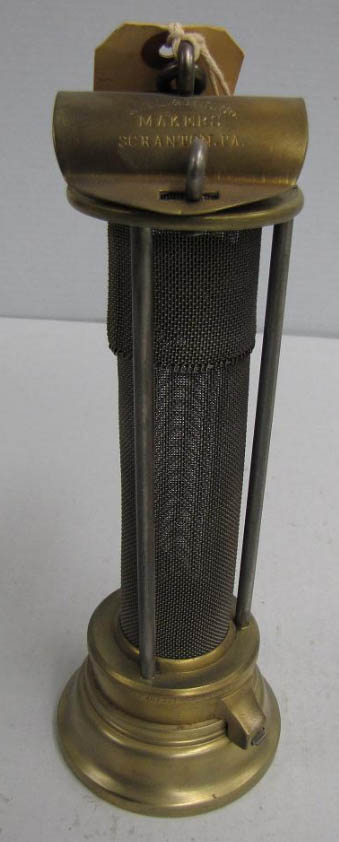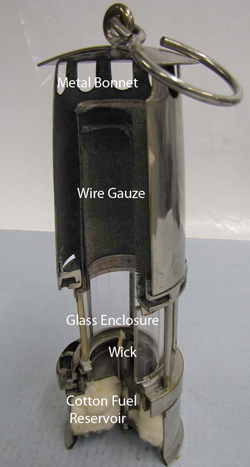 |
Davy-stayle Safety Lamp, Scranton, Pennsylvania, ca. late 1900s
|
The unforgiving darkness of a mine necessitated the use of a light. Before the 19th century, this forced miners to use open flames that had the potential to ignite the flammable gasses inside mines, causing lethal explosions. The flammable gas (firedamp) consisted mainly of methane and was most often found in coal mines. A need was seen to provide a safe light for miners to use in gaseous mines, and several inventors set upon the task independently. The three main progenitors of early safety lamps were Dr. William Reid Clanny, Sir Humphry Davy, and George Stephenson.
The first to set upon the idea of a safety lamp was Dr. William Clanny. As a physician in Sunderland, England, Clanny routinely attended to patients injured in mining explosions. In 1813 Clanny revealed his first design for a lamp in a paper to the Royal Philosophical Society. Clanny enclosed the flame in glass with layers of water above and below the flame to "seal in the fire." A bellows supplied oxygen through a tube into the chamber to keep the flame alight. The bellows made this lamp impractical for daily use, and the flame was extinguished when tested in a mixture of inflammable gas.
George Stephenson was an English engineer who also began to try to invent a safe lamp in 1815. Through trial and error he came upon a design that worked. He encased the lamp in a glass cylinder, which was capped with a metallic cover with tiny holes. This was covered with a metal bonnet to further remove the flame from the dangers of the flammable gas.
 |
Cutaway of a Safety Lamp
|
The Englishman Sir Humphry Davy was already a scientist and inventor of national renown when he seized upon the idea of a safety lamp in 1815. Davy had performed numerous scientific experiments on all natures of gasses, and this experience proved useful in battling the flammable firedamp found in gaseous mines. Davy’s invention was to surround the flame with a metallic mesh screen. Air could pass through the screen to fuel the flame, but if the holes in the screen were small enough, the mesh would cool the flame to such an extent that it could not ignite the gas surrounding the lamp. This design allowed the Davy lamp to serve as a test for the presences of certain gasses. If firedamp was present, the flame would burn with a blue “cap.” The length of the cap would determine how much gas was present. Some lamps in the collection are these so called “test lamps” with marks in the lamp's glass used to measure the flame’s cap. While flammable gasses were the most prominent threat in mines, asphyxiant gasses also presented a danger. Davy’s safety lamp helped with this issue as well, as miners could use Davy’s lamp to check for harmful concentrations of carbon dioxide, which would extinguish the flame at a non-lethal concentration, alerting the miner’s to unsafe working conditions.
Although safety lamps addressed the issue of mining explosions, they did not become as numerous as other mining lights for a variety of reasons. Many miners objected to using safety lamps because they were cumbersome, could not be worn on the cap, and gave a poor light, which all served to reduce a miner’s efficiency. Since most miners were paid by the pound, a reduction in efficiency amounted to a reduction in pay, and so the risk of an explosion was a chance miners were willing to take. Additionally, many miners objected to the false confidence instilled in many who used a safety lamp, and claimed that safety lamps obscured the real issue of unsafe working conditions and would hinder the development of improved ventilation needed in mines. Safety lamps had one unique advantage—they could safely burn off methane in mines which kept them in use by mine bosses even after the invention of battery-powered lamps.
Safety lamps were manufactured by a variety of companies from around 1815 until the 1930s, and incorporated elements of their design from Clanny, Stephenson, and Davy. Most of the safety lamps in the collection of the Division of Work and Industry include all three inventor’s contributions towards a safety lamp—a glass enclosure around the flame for more effective lighting, mesh uppers to cool the flame, and metal bonnet to better protect the flame from being extinguished by gusts or drafts in mines.


